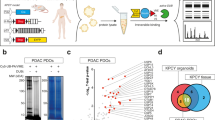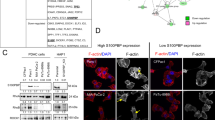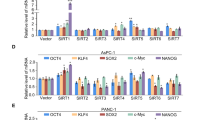Abstract
Pancreatic ductal adenocarcinoma (PDA) remains a lethal malignancy despite much progress concerning its molecular characterization. PDA tumours harbour four signature somatic mutations1,2,3,4 in addition to numerous lower frequency genetic events of uncertain significance5. Here we use Sleeping Beauty (SB) transposon-mediated insertional mutagenesis6,7 in a mouse model of pancreatic ductal preneoplasia8 to identify genes that cooperate with oncogenic KrasG12D to accelerate tumorigenesis and promote progression. Our screen revealed new candidate genes for PDA and confirmed the importance of many genes and pathways previously implicated in human PDA. The most commonly mutated gene was the X-linked deubiquitinase Usp9x, which was inactivated in over 50% of the tumours. Although previous work had attributed a pro-survival role to USP9X in human neoplasia9, we found instead that loss of Usp9x enhances transformation and protects pancreatic cancer cells from anoikis. Clinically, low USP9X protein and messenger RNA expression in PDA correlates with poor survival after surgery, and USP9X levels are inversely associated with metastatic burden in advanced disease. Furthermore, chromatin modulation with trichostatin A or 5-aza-2′-deoxycytidine elevates USP9X expression in human PDA cell lines, indicating a clinical approach for certain patients. The conditional deletion of Usp9x cooperated with KrasG12D to accelerate pancreatic tumorigenesis in mice, validating their genetic interaction. We propose that USP9X is a major tumour suppressor gene with prognostic and therapeutic relevance in PDA.
This is a preview of subscription content, access via your institution
Access options
Subscribe to this journal
Receive 51 print issues and online access
$199.00 per year
only $3.90 per issue
Buy this article
- Purchase on Springer Link
- Instant access to full article PDF
Prices may be subject to local taxes which are calculated during checkout



Similar content being viewed by others
References
Almoguera, C. et al. Most human carcinomas of the exocrine pancreas contain mutant c-K-ras genes. Cell 53, 549–554 (1988)
Caldas, C. et al. Frequent somatic mutations and homozygous deletions of the p16 (MTS1) gene in pancreatic adenocarcinoma. Nature Genet. 8, 27–32 (1994)
Redston, M. S. et al. p53 mutations in pancreatic carcinoma and evidence of common involvement of homocopolymer tracts in DNA microdeletions. Cancer Res. 54, 3025–3033 (1994)
Hahn, S. A. et al. DPC4, a candidate tumor suppressor gene at human chromosome 18q21.1. Science 271, 350–353 (1996)
Jones, S. et al. Core signaling pathways in human pancreatic cancers revealed by global genomic analyses. Science 321, 1801–1806 (2008)
Collier, L. S., Carlson, C. M., Ravimohan, S., Dupuy, A. J. & Largaespada, D. A. Cancer gene discovery in solid tumours using transposon-based somatic mutagenesis in the mouse. Nature 436, 272–276 (2005)
Dupuy, A. J., Akagi, K., Largaespada, D. A., Copeland, N. G. & Jenkins, N. A. Mammalian mutagenesis using a highly mobile somatic Sleeping Beauty transposon system. Nature 436, 221–226 (2005)
Hingorani, S. R. et al. Preinvasive and invasive ductal pancreatic cancer and its early detection in the mouse. Cancer Cell 4, 437–450 (2003)
Schwickart, M. et al. Deubiquitinase USP9X stabilizes MCL1 and promotes tumour cell survival. Nature 463, 103–107 (2010)
Keng, V. W. et al. A conditional transposon-based insertional mutagenesis screen for genes associated with mouse hepatocellular carcinoma. Nature Biotechnol. 27, 264–274 (2009)
Starr, T. K. et al. A transposon-based genetic screen in mice identifies genes altered in colorectal cancer. Science 323, 1747–1750 (2009)
Collier, L. S. et al. Whole-body sleeping beauty mutagenesis can cause penetrant leukemia/lymphoma and rare high-grade glioma without associated embryonic lethality. Cancer Res. 69, 8429–8437 (2009)
Avizienyte, E. et al. LKB1 somatic mutations in sporadic tumors. Am. J. Pathol. 154, 677–681 (1999)
Varela, I. et al. Exome sequencing identifies frequent mutation of the SWI/SNF complex gene PBRM1 in renal carcinoma. Nature 469, 539–542 (2011)
Su, G. H. et al. ACVR1B (ALK4, activin receptor type 1B) gene mutations in pancreatic carcinoma. Proc. Natl Acad. Sci. USA 98, 3254–3257 (2001)
Li, M. et al. Deubiquitination of p53 by HAUSP is an important pathway for p53 stabilization. Nature 416, 648–653 (2002)
Dupont, S. et al. FAM/USP9x, a deubiquitinating enzyme essential for TGFβ signaling, controls Smad4 monoubiquitination. Cell 136, 123–135 (2009)
Nagai, H. et al. Ubiquitin-like sequence in ASK1 plays critical roles in the recognition and stabilization by USP9X and oxidative stress-induced cell death. Mol. Cell 36, 805–818 (2009)
Sun, H. et al. Bcr-Abl ubiquitination and Usp9x inhibition block kinase signaling and promote CML cell apoptosis. Blood 117, 3151–3162 (2011)
Mouchantaf, R. et al. The ubiquitin ligase itch is auto-ubiquitylated in vivo and in vitro but is protected from degradation by interacting with the deubiquitylating enzyme FAM/USP9X. J. Biol. Chem. 281, 38738–38747 (2006)
Bernassola, F., Karin, M., Ciechanover, A. & Melino, G. The HECT family of E3 ubiquitin ligases: multiple players in cancer development. Cancer Cell 14, 10–21 (2008)
Wang, X., Soloway, P. D. & Clark, A. G. Paternally biased X inactivation in mouse neonatal brain. Genome Biol. 11, R79 (2010)
Yang, F., Babak, T., Shendure, J. & Disteche, C. M. Global survey of escape from X inactivation by RNA-sequencing in mouse. Genome Res. 20, 614–622 (2010)
Jackson, E. L. et al. Analysis of lung tumor initiation and progression using conditional expression of oncogenic K-ras. Genes Dev. 15, 3243–3248 (2001)
March, H. N. et al. Insertional mutagenesis identifies multiple networks of cooperating genes driving intestinal tumorigenesis. Nature Genet. 43, 1202–1209 (2011)
Uren, A. G. et al. A high-throughput splinkerette-PCR method for the isolation and sequencing of retroviral insertion sites. Nature Protocols 4, 789–798 (2009)
Tompers, D. M. & Labosky, P. A. Electroporation of murine embryonic stem cells: a step-by-step guide. Stem Cells 22, 243–249 (2004)
de Ridder, J., Uren, A., Kool, J., Reinders, M. & Wessels, L. Detecting statistically significant common insertion sites in retroviral insertional mutagenesis screens. PLOS Comput. Biol. 2, e166 (2006)
Grützmann, R. et al. Gene expression profiling of microdissected pancreatic ductal carcinomas using high-density DNA microarrays. Neoplasia 6, 611–622 (2004)
Pilarsky, C. et al. Activation of Wnt signalling in stroma from pancreatic cancer identified by gene expression profiling. J. Cell. Mol. Med. 12, 2823–2835 (2008)
Oberdoerffer, P. et al. Efficiency of RNA interference in the mouse hematopoietic system varies between cell types and developmental stages. Mol. Cell. Biol. 25, 3896–3905 (2005)
Nathan, J. A. et al. The ubiquitin E3 ligase MARCH7 is differentially regulated by the deubiquitylating enzymes USP7 and USP9X. Traffic 9, 1130–1145 (2008)
Murray, R. Z., Jolly, L. A. & Wood, S. A. The FAM deubiquitylating enzyme localizes to multiple points of protein trafficking in epithelia, where it associates with E-cadherin and beta-catenin. Mol. Biol. Cell 15, 1591–1599 (2004)
Olive, K. P. et al. Inhibition of Hedgehog signaling enhances delivery of chemotherapy in a mouse model of pancreatic cancer. Science 324, 1457–1461 (2009)
Ouyang, H. et al. Immortal human pancreatic duct epithelial cell lines with near normal genotype and phenotype. Am. J. Pathol. 157, 1623–1631 (2000)
Furukawa, T. et al. Long-term culture and immortalization of epithelial cells from normal adult human pancreatic ducts transfected by the E6E7 gene of human papilloma virus 16. Am. J. Pathol. 148, 1763–1770 (1996)
Debnath, J., Muthuswamy, S. K. & Brugge, J. S. Morphogenesis and oncogenesis of MCF-10A mammary epithelial acini grown in three-dimensional basement membrane cultures. Methods 30, 256–268 (2003)
Iacobuzio-Donahue, C. A. et al. DPC4 gene status of the primary carcinoma correlates with patterns of failure in patients with pancreatic cancer. J. Clin. Oncol. 27, 1806–1813 (2009)
Acknowledgements
We thank P. Labosky for assistance in generating the Rosa26-LSL-SB13 mouse; B. Bhagavan for pathology consultation; M. Tsao for providing the HPDE cell line; and N. Copeland and K. Mann for sharing pre-published information. We thank A. Gopinathan, H. Tiriac, D. Engle, D. Chan, F. Connor, S. Derkits and other members of the Tuveson laboratory for assistance and advice, and the animal care staff and histology core at CRI, and The University of Minnesota’s Mouse Genetics Laboratory. This research was supported by the University of Cambridge and Cancer Research UK, The Li Ka Shing Foundation and Hutchison Whampoa Limited, the NIHR Cambridge Biomedical Research Centre, and the NIH (2P50CA101955 SPORE grant to D.A.T., D.A.L. and C.A.I.-D.; grants CA62924, CA128920 and CA106610 to C.A.I.-D.; P50CA62924 SPORE grant to R.H.H. and C.A.I.-D.; and CA122183 to L.S.C.). D.J.A. is supported by Cancer Research UK and the Wellcome Trust. L.v.d.W. is supported by the Kay Kendall Leukemia Fund. C.P. is supported by Wilhelm Sander Stiftung (2009.039.1) and Deutsche Forschungsgemeinschaft (PI 341/5-1). A.V.B., D.K.C., S.M.G. and the APGI investigators are funded by the University of Verona and Italian Ministry of University and Research (FIRB RBAP10AHJB); the National Health and Medical research Council of Australia (NHMRC); Queensland Government; Cancer Council NSW; Australian Cancer Research Foundation; Cancer Institute NSW; The Avner Nahmani Pancreatic Cancer Research Foundation; and the R.T. Hall Trust. S.A.W. was supported by the NHMRC. Additional support was obtained from Fundación Ibercaja (P.A.P.-M.).
Author information
Authors and Affiliations
Consortia
Contributions
P.A.P.-M. performed the majority of all experiments, designed experiments, analysed data, and wrote the manuscript. L.v.d.W. and J.A.B. performed in vitro experiments. S.S. and S.A.W. generated the conditional Usp9x mouse. L.S.C. provided the CAGGS-SB10 and T2/Onc mice. A.G.R., A.L.S., K.A.T.S., J.J.t.H., J.d.R. and L.F.A.W. conducted the CIS data analysis. G.K., R.G., D.A., P.R., T.K. and C.P. generated data from resected pancreatic tumours. Allen Li, R.H.H., R.M., S.K., J.Y., Ang Li, M.G. and C.A.I.-D. analysed human samples from autopsy series, and analysed mouse pathology and methylation studies. C.H., D.L.S. and R.K. sequenced PDA human samples from autopsy series. A.P.K. provided statistical analyses for the human PDA data sets. APGI, D.K.C., S.M.G. and A.V.B. generated and analysed data from ICGC/APGI (International Cancer Genome Consortium/Australian Pancreatic Cancer Genome Initiative). D.A.L. provided the CAGGS-SB10 and T2/Onc mice, and analysed data. D.J.A. and D.A.T. designed the study, analysed the data, and wrote the manuscript. All authors commented upon and edited the final manuscript.
Corresponding authors
Ethics declarations
Competing interests
The authors declare no competing financial interests.
Supplementary information
Supplementary Information
This file contains Supplementary Figures 1-19, Supplementary Tables 1 and 5-11, full legends for Tables 2-4 and an additional reference. (PDF 15995 kb)
Supplementary Table 2
This table shows candidate CIS genes in pancreas tumours from KCTSB13 mice. (XLS 264 kb)
Supplementary Table 3
This file contains Supplementary Tables 3a and 3b as BED files which list non-redundant insertions. (ZIP 1026 kb)
Supplementary Table 4
This table shows comparison of KCTSB13 CISs to prior work in human PDA. (XLS 228 kb)
Rights and permissions
About this article
Cite this article
Pérez-Mancera, P., Rust, A., van der Weyden, L. et al. The deubiquitinase USP9X suppresses pancreatic ductal adenocarcinoma. Nature 486, 266–270 (2012). https://doi.org/10.1038/nature11114
Received:
Accepted:
Published:
Issue Date:
DOI: https://doi.org/10.1038/nature11114
This article is cited by
-
High-throughput functional screen identifies YWHAZ as a key regulator of pancreatic cancer metastasis
Cell Death & Disease (2023)
-
Pro-apoptotic and anti-apoptotic regulation mediated by deubiquitinating enzymes
Cellular and Molecular Life Sciences (2022)
-
Elevated USP9X drives early-to-late-stage oral tumorigenesis via stabilisation of anti-apoptotic MCL-1 protein and impacts outcome in oral cancers
British Journal of Cancer (2021)
-
CRISPR and transposon in vivo screens for cancer drivers and therapeutic targets
Genome Biology (2020)
-
Ubiquitination and deubiquitination of MCL1 in cancer: deciphering chemoresistance mechanisms and providing potential therapeutic options
Cell Death & Disease (2020)
Comments
By submitting a comment you agree to abide by our Terms and Community Guidelines. If you find something abusive or that does not comply with our terms or guidelines please flag it as inappropriate.



